
Solenostemon is a former genus of flowering plants in the family Lamiaceae. It has been included in the genus Plectranthus, but is now included in an expanded Coleus. They are native to tropical Africa, Asia and Australia. Some species formerly placed in this genus are cultivated for their highly variegated leaves.

Linaria is a genus of almost 200 species of flowering plants, one of several related groups commonly called toadflax. They are annuals and herbaceous perennials, and the largest genus in the Antirrhineae tribe of the plantain family Plantaginaceae.

Aubrieta is a genus of about 20 species of flowering plants in the cabbage family Brassicaceae. The genus is named after Claude Aubriet, a French flower painter. It originates from southern Europe east to central Asia but is now a common garden escape throughout Europe. It is a low, spreading plant, hardy, evergreen and perennial. It has small violet, pink, or white flowers, and it inhabits rocks and banks. It prefers light, well-drained soil, is tolerant of a wide pH range, and can grow in partial shade or full sun.

Alcea is a genus of over 80 species of flowering plants in the mallow family Malvaceae, commonly known as the hollyhocks. They are native to Asia and Europe. The single species of hollyhock from the Americas, the streambank wild hollyhock, belongs to a different genus.

Anacyclus is a genus of plants in the family Asteraceae described by Linnaeus in 1753. Annuals or herbaceous perennials, they are cultivated for their fern-like leaves on creeping, radiating stems and daisy-like flowers. They are frost-hardy but may tolerate winter temperatures below −5 °C (23 °F) if grown in well-drained soil.

Rhamnus is a genus of about 140 accepted species of shrubs or small trees, commonly known as buckthorns, in the family Rhamnaceae. Its species range from 1 to 10 m tall and are native mainly in east Asia and North America, but found throughout the temperate and subtropical Northern Hemisphere, and also more locally in the subtropical Southern Hemisphere in parts of Africa and South America. One species, the common buckthorn, is able to flourish as an invasive plant in parts of Canada and the U.S., where it has become naturalized.
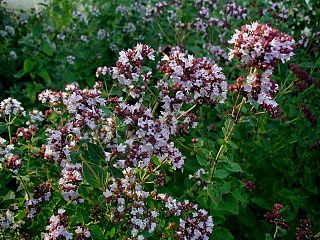
Origanum is a genus of herbaceous perennial flowering plants and subshrubs in the family Lamiaceae. They are native to Europe, North Africa, and much of temperate Asia, where they are found in open or mountainous habitats. A few species also naturalized in scattered locations in North America and other regions.

Aethionema is a genus of flowering plants within the family Brassicaceae. They are known as stonecresses. Stonecresses originate from sunny limestone mountainsides in Europe and West Asia, especially Turkey.

Geranium sylvaticum, the wood cranesbill or woodland geranium, is a species of hardy flowering plant in the family Geraniaceae, native to Europe and northern Turkey.

Erodium is a genus of flowering plants in the botanical family Geraniaceae. The genus includes about 120 species with a subcosmopolitan distribution, native to Europe, North Africa, Asia, Australia, and more locally in North and South America. They are perennials, annuals, or subshrubs, with five-petalled flowers in shades of white, pink, and purple, that strongly resemble the better-known Geranium (crane's-bills). In English-speaking areas of Europe, the species are known as stork's-bills. In North America they are known as filarees or heron's bill.
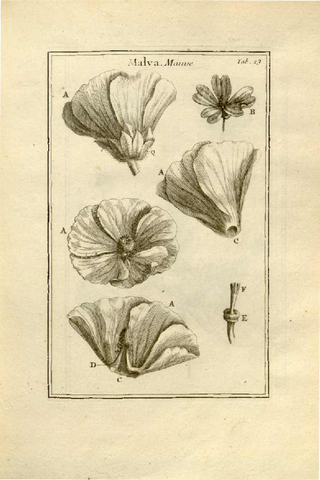
Claude Aubriet was a French illustrator and botanical artist. The standard author abbreviation Aubriet is used to indicate this person as the author when citing a botanical name.

Aubrieta deltoidea is a species of flowering plant in the mustard family. Common names include lilacbush, purple rock cress and rainbow rock cress. It should be grown in zones 4a to 9b.
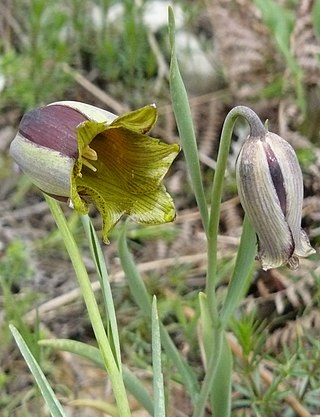
Fritillaria acmopetala, the pointed-petal fritillary, is a species of flowering plant in the lily family Liliaceae, native to rocky limestone mountain slopes in the Middle East. It was described by the Swiss botanist Pierre Edmond Boissier in 1846.

Geranium renardii is a species of hardy flowering herbaceous perennial plant in the genus Geranium, in the family Geraniaceae. It is native to the Caucasus region between Europe and Asia. Growing to 30 cm (12 in) tall and broad, it has palmate leaves and pale pink flowers striped violet. This plant has gained the Royal Horticultural Society's Award of Garden Merit. It grows well in sunny positions or shade both and well drained soils.

Iris lutescens, the Crimean iris, is a rhizomatous flowering plant in the genus Iris. It is native to North East Spain, Southern France and Italy. It is found on rocky or sandy hillsides or in woodlands.

Origanum laevigatum is a species of flowering plant in the family Lamiaceae, native to Cyprus, Syria, and Turkey. Growing to 50–60 cm (20–24 in) tall by 45 cm (18 in) wide, it is a woody-based perennial, with strongly aromatic leaves, and loose clusters of pink funnel-shaped flowers with persistent purple bracts, throughout the summer.

Allium karataviense is an Asian species of onion in the Amaryllis family. It is commonly known as Turkistan onion or ornamental onion.
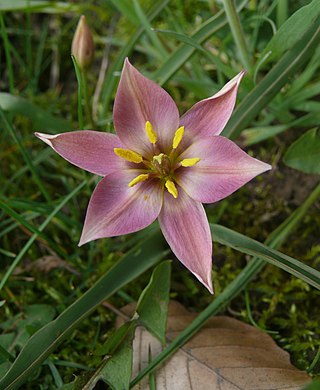
Tulipa humilis is a species of flowering plant in the lily family, found in Syria, Lebanon, Palestine, Turkey, Iran, and the North Caucasus region of Russia. The flowers are pink with yellow centers. Its preferred habitat are rocky mountain slopes. It is known by several other names in horticulture.

Acantholimon libanoticum(Lebanese prickly thrift, غملول لبناني) is a plant in the family Plumbaginaceae first described by Pierre Edmond Boissier. It is native to Western Asia from Turkey to Syria and Lebanon.
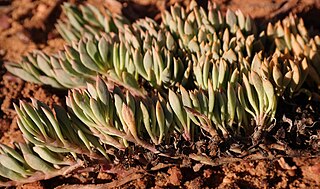
Acrosanthes is a genus of flowering plants in the family Aizoaceae. It is native to the Namibia and South Africa's Cape Provinces in Southern Africa.




















